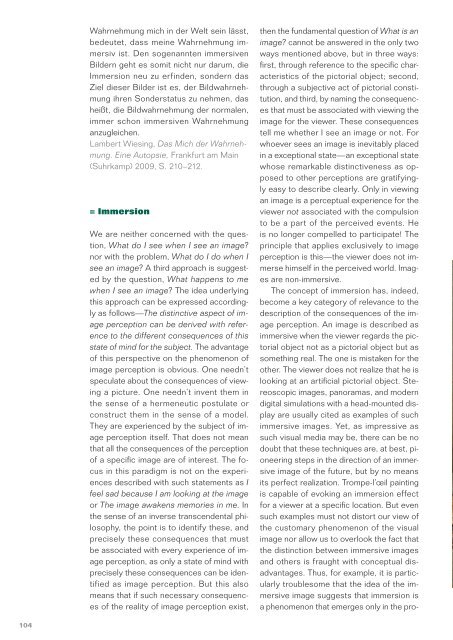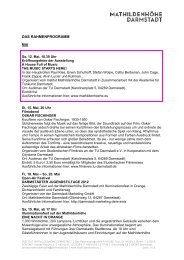Peggy Ahwesh Oliver van den Berg Wafaa Bilal ... - Mathildenhöhe
Peggy Ahwesh Oliver van den Berg Wafaa Bilal ... - Mathildenhöhe
Peggy Ahwesh Oliver van den Berg Wafaa Bilal ... - Mathildenhöhe
Sie wollen auch ein ePaper? Erhöhen Sie die Reichweite Ihrer Titel.
YUMPU macht aus Druck-PDFs automatisch weboptimierte ePaper, die Google liebt.
Wahrnehmung mich in der Welt sein lässt,<br />
bedeutet, dass meine Wahrnehmung immersiv<br />
ist. Den sogenannten immersiven<br />
Bildern geht es somit nicht nur darum, die<br />
Immersion neu zu erfin<strong>den</strong>, sondern das<br />
Ziel dieser Bilder ist es, der Bildwahrnehmung<br />
ihren Sonderstatus zu nehmen, das<br />
heißt, die Bildwahrnehmung der normalen,<br />
immer schon immersiven Wahrnehmung<br />
anzugleichen.<br />
Lambert Wiesing, Das Mich der Wahrnehmung.<br />
Eine Autopsie, Frankfurt am Main<br />
(Suhrkamp) 2009, S. 210–212.<br />
= Immersion<br />
We are neither concerned with the question,<br />
What do I see when I see an image?<br />
nor with the problem, What do I do when I<br />
see an image? A third approach is suggested<br />
by the question, What happens to me<br />
when I see an image? The idea underlying<br />
this approach can be expressed accordingly<br />
as follows—The distinctive aspect of image<br />
perception can be derived with reference<br />
to the different consequences of this<br />
state of mind for the subject. The ad<strong>van</strong>tage<br />
of this perspective on the phenomenon of<br />
image perception is obvious. One needn’t<br />
speculate about the consequences of viewing<br />
a picture. One needn’t invent them in<br />
the sense of a hermeneutic postulate or<br />
construct them in the sense of a model.<br />
They are experienced by the subject of image<br />
perception itself. That does not mean<br />
that all the consequences of the perception<br />
of a specific image are of interest. The focus<br />
in this paradigm is not on the experiences<br />
described with such statements as I<br />
feel sad because I am looking at the image<br />
or The image awakens memories in me. In<br />
the sense of an inverse transcen<strong>den</strong>tal philosophy,<br />
the point is to i<strong>den</strong>tify these, and<br />
precisely these consequences that must<br />
be associated with every experience of image<br />
perception, as only a state of mind with<br />
precisely these consequences can be i<strong>den</strong>tified<br />
as image perception. But this also<br />
means that if such necessary consequences<br />
of the reality of image perception exist,<br />
then the fundamental question of What is an<br />
image? cannot be answered in the only two<br />
ways mentioned above, but in three ways:<br />
first, through reference to the specific characteristics<br />
of the pictorial object; second,<br />
through a subjective act of pictorial constitution,<br />
and third, by naming the consequences<br />
that must be associated with viewing the<br />
image for the viewer. These consequences<br />
tell me whether I see an image or not. For<br />
whoever sees an image is inevitably placed<br />
in a exceptional state—an exceptional state<br />
whose remarkable distinctiveness as opposed<br />
to other perceptions are gratifyingly<br />
easy to describe clearly. Only in viewing<br />
an image is a perceptual experience for the<br />
viewer not associated with the compulsion<br />
to be a part of the perceived events. He<br />
is no longer compelled to participate! The<br />
principle that applies exclusively to image<br />
perception is this—the viewer does not immerse<br />
himself in the perceived world. Images<br />
are non-immersive.<br />
The concept of immersion has, indeed,<br />
become a key category of rele<strong>van</strong>ce to the<br />
description of the consequences of the image<br />
perception. An image is described as<br />
immersive when the viewer regards the pictorial<br />
object not as a pictorial object but as<br />
something real. The one is mistaken for the<br />
other. The viewer does not realize that he is<br />
looking at an artificial pictorial object. Stereoscopic<br />
images, panoramas, and modern<br />
digital simulations with a head-mounted display<br />
are usually cited as examples of such<br />
immersive images. Yet, as impressive as<br />
such visual media may be, there can be no<br />
doubt that these techniques are, at best, pioneering<br />
steps in the direction of an immersive<br />
image of the future, but by no means<br />
its perfect realization. Trompe-l’œil painting<br />
is capable of evoking an immersion effect<br />
for a viewer at a specific location. But even<br />
such examples must not distort our view of<br />
the customary phenomenon of the visual<br />
image nor allow us to overlook the fact that<br />
the distinction between immersive images<br />
and others is fraught with conceptual disad<strong>van</strong>tages.<br />
Thus, for example, it is particularly<br />
troublesome that the idea of the immersive<br />
image suggests that immersion is<br />
a phenomenon that emerges only in the pro-<br />
cess of viewing certain images—as if the<br />
viewer could experience immersion only by<br />
viewing immersive images. Yet, that is definitely<br />
not the case. Immersion is experienced<br />
by anyone who perceives at all. That<br />
person immerses himself in the perceived<br />
world. The fact that my perceptual faculties<br />
enable me to enter that world means<br />
that my perception is immersive. Thus, the<br />
purpose of so-called immersive images is,<br />
therefore, not merely to reinvent immersion.<br />
The goal of such pictures is to strip image<br />
perception of its unique status, that is, to<br />
bring image perception in line with normal<br />
perception, which is always immersive.<br />
Lambert Wiesing, Das Mich der Wahrnehmung.<br />
Eine Autopsie (Frankfurt am Main,<br />
Suhrkamp, 2009), pp. 210–12.<br />
(Translation by John Southard)<br />
Harun Farocki, Ernste Spiele III: Immersion / Serious Games III: Immersion, 2009, Material aus der Produktion /<br />
Footage from the production<br />
104 105









